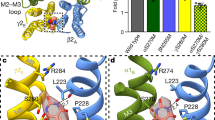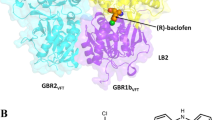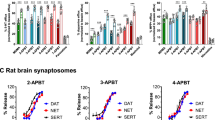Abstract
High-affinity binding of 3H-diazepam and 3H-flunitrazepam has provided evidence for the presence of benzodiazepine receptors on brain neurones1–6. Pharmacological evidence showing a clear correlation between receptor affinity and in vivo pharmacological potency for several benzodiazepines7 and a link between benzodiazepine receptors and GABA (γ-aminobutyric acid) receptors at the molecular level8,9, indicates that these receptors are relevant to the pharmacological and clinical effects of benzodiazepines. In searching for possible endogeneous ligands for benzodiazepine receptors we have recently isolated ethyl β-carboline-3-carboxylate (β-CCE) from human urine and brain, and shown that β-CCE has a higher affinity than diazepam for brain benzodiazepine receptors10. β-CCE itself is probably not present in the brain, but may be closely related to an endogenous benzodiazepine receptor ligand10. We report here that β-CCE, in contrast to benzodiazepines, can distinguish clearly between benzodiazepine receptors in cerebellum and hippocampus. This result strongly indicates that benzodiazepine receptors are not a single class of non-interacting entities. It has not been possible to determine whether two distinct receptors are present and/or whether true negative cooperativity exists among hippocampal, but not cerebellar, benzodiazepine receptors.
This is a preview of subscription content, access via your institution
Access options
Subscribe to this journal
Receive 51 print issues and online access
$199.00 per year
only $3.90 per issue
Buy this article
- Purchase on Springer Link
- Instant access to full article PDF
Prices may be subject to local taxes which are calculated during checkout
Similar content being viewed by others
References
Squires, R. F. & Bræstrup, C. Nature 266, 732–734 (1977).
Bræstrup, C. & Squires, R. F. Proc. natn. Acad. Sci. U.S.A. 74, 3805–3809 (1977).
Möhler, H. & Okada, T. Science 198, 849–851 (1977).
Mackerer, C. R., Kochman, R. L., Bierschenck, A. & Bremner, S. S. J. Pharmac. exp. Ther. 206, 405–413 (1978).
Speth, R. C., Wastek, G. J., Johnson, P. C. & Yamamura, H. I. Life Sci. 22, 859–866 (1978).
Bræstrup, C., Nielsen, M., Biggio, G. & Squires, R. F. Neurosci. Lett. 13, 219–224 (1979).
Bræstrup, C. & Squires, R. F. Eur. J. Pharmac. 48, 263–270 (1978).
Tallman, J. F., Thomas, J. W. & Gallager, D. W. Nature 274, 383–385 (1978).
Guidotti, A., Toffano, G. & Costa, E. Nature 275, 553–555 (1978).
Brastrup, C., Nielsen, M. & Olsen, C.-E. Proc. natn. Acad. Sci. U.S.A. 77, 2288–2292 (1980).
Bræstrup, C., Nielsen, M., Krogsgaard-Larsen, P. & Falch, E. Nature 280, 331–333 (1979).
Karobath, M. & Sperk, G. Proc. natn. Acad. Sci. U.S.A. 76, 1004–1006 (1979).
Beaumont, K., Chilton, W. S., Yamamura, H. I. & Enna, S. J. Brain Res. 148, 153–162 (1978).
Squires, R. F. et al. Pharmac. Biochem. Behav. 10, 825–830 (1979).
Costa, T., Rodbard, D. & Pert, C. B. Nature 277, 315–317 (1979).
Nielsen, M., Bræstrup, C. & Squires, R. F. Brain Res. 141, 342–346 (1978).
Battersby, M. K., Richards, J. G. & Möhler, H. Eur. J. Pharmac. 57, 277–278 (1979).
Tallman, J. F. et al. in Receptors for Neurotransmitters and Peptide Hormones (eds Pepeu, G., Kuhar, J. & Enna, S. J.) 277–283 (Raven, New York, 1980).
Birdsall, N. J. M., Burgen, A. S. V. & Hulme, E. C. Molec. Pharmac. 14, 723–736 (1978).
Bradbury, A. F., Smith, D. G., Snell, C. R., Birdsall, N. J. M. & Hulme, E. C. Nature 260, 793–795 (1976).
Lefkowitz, R. J., Mullikin, D. & Caron, M. G. J. biol Chem. 251, 4686–4692 (1976).
Creese, I., Usdin, T. & Snyder, S. H. Nature 278, 577–578 (1979).
Lippa, A. S. et al. Brain Res. Bull. 5, Suppl. 2 (in the press).
Author information
Authors and Affiliations
Rights and permissions
About this article
Cite this article
Nielsen, M., Bræstrup, C. Ethyl β-carboline-3-carboxylate shows differential benzodiazepine receptor interaction. Nature 286, 606–607 (1980). https://doi.org/10.1038/286606a0
Received:
Accepted:
Issue Date:
DOI: https://doi.org/10.1038/286606a0
This article is cited by
-
Pharmacological and Biochemical Aspects of GABAergic Neurotransmission: Pathological and Neuropsychobiological Relationships
Cellular and Molecular Neurobiology (2004)
-
The diversity of GABAA receptors
Molecular Neurobiology (1998)
-
Evidence for the presence of a benzodiazepine receptor binding substance in cerebrospinal fluid of a rabbit model of hepatic encephalopathy
Metabolic Brain Disease (1989)
-
Anxiogenic properties of beta-CCE and FG 7142: a review of promises and pitfalls
Psychopharmacology (1988)
Comments
By submitting a comment you agree to abide by our Terms and Community Guidelines. If you find something abusive or that does not comply with our terms or guidelines please flag it as inappropriate.



